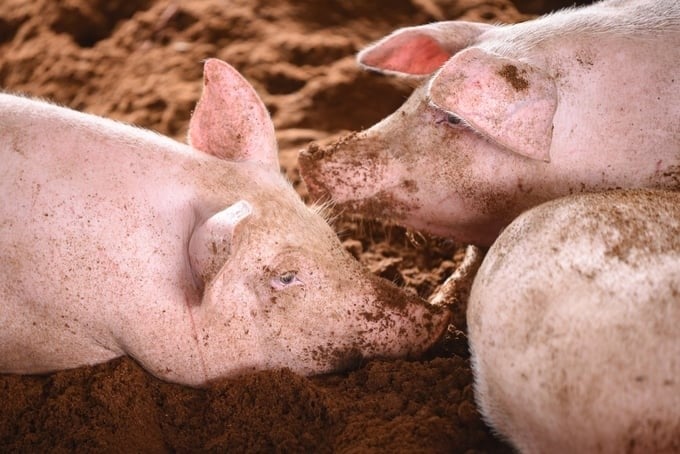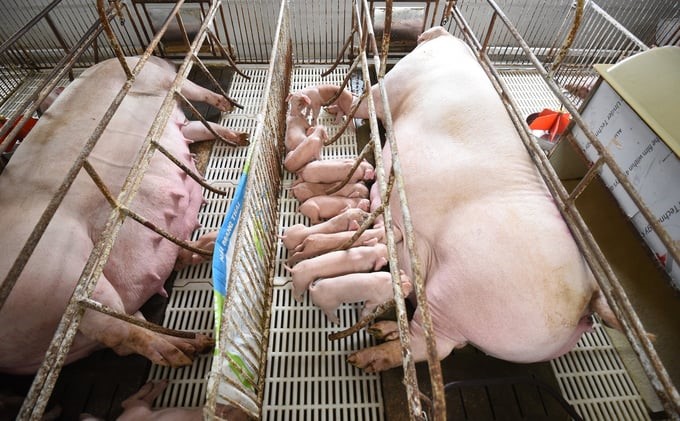November 27, 2025 | 01:34 GMT +7
November 27, 2025 | 01:34 GMT +7
Hotline: 0913.378.918
November 27, 2025 | 01:34 GMT +7
Hotline: 0913.378.918

Industrial livestock production is a major source of greenhouse gas emissions. Photo: Tung Dinh.
To clarify the issue of greenhouse gas inventory, on the morning of April 11, Deputy Minister of Agriculture and Rural Development Phung Duc Tien had a working session with the Department of Livestock Production, the Department of Science Technology and Environment, and relevant livestock enterprises and associations.
After listening to the opinions, Deputy Minister Phung Duc Tien commented that this is a new issue and is part of the process of bringing net emissions to "zero" by 2050, as the Vietnamese Government committed to at COP26.
However, the Deputy Minister also assumed: "Selling carbon credits is a long-term story. The issue of how to sell and to whom requires balance on a national scale."
Particularly regarding greenhouse gas inventory, the leader of the Ministry of Agriculture and Rural Development raised the issue of the green development trend that is growing at the global level, so greenhouse gas inventory is the work that must be done, but in the immediate future, it is necessary to clarify the measurement method and identify organizations for recognition capabilities.
Giving general direction on greenhouse gas inventory, Deputy Minister Phung Duc Tien emphasized: "To do this, it is first necessary to understand the current situation and build a specific roadmap for the livestock industry. In addition, enterprises and associations need to pioneer and be able to share experiences in implementing greenhouse gas inventory."
At the working session, representatives of some enterprises had their opinions on this issue. Most of them supported the policy and committed to its implementation. However, because greenhouse gas inventory is a new issue, costs are still high and regulations are not detailed. Therefore, enterprises suggested more companionship from state management agencies with specific orientation and guidance. In addition, there are also opinions about extending the implementation time and progress.

Large-scale livestock facilities need to conduct greenhouse gas inventory. Photo: Tung Dinh.
Previously, the Department of Livestock Production recommended that Vietnam apply for and require large-scale livestock facilities to conduct greenhouse gas inventory.
According to the Department of Livestock Production, industrial livestock production is one of the sources of environmental pollution and has been contributing significantly to Vietnam's total greenhouse gas emissions.
Inventory results show that greenhouse gas emissions from cow and pig farming always account for the largest portion of the industry's total greenhouse gas emissions.
Methane emissions from animal manure are caused by anaerobic conditions in biogas tunnels or in places where animal manure is stored in large quantities but with poor ventilation conditions. Therefore, the largest methane emissions often occur in animals with concentrated farming and using a lot of water to clean barns, such as market hog farming.
Looking at the experience of reducing greenhouse gas emissions in countries with advanced livestock industries such as China, the US, Japan, Thailand, etc., the greenhouse gas management and reporting requirements of developed and developing countries always require the participation of industrial and agricultural facilities in reporting periods.
On that basis, for the livestock industry, it is recommended that Vietnam apply the management of greenhouse gas emission data of livestock facilities based on calculations and operational data of the Ministry of Agriculture and Rural Development. Of which, it is essential to require large-scale livestock facilities to conduct greenhouse gas inventory.
According to information from the Ministry of Agriculture and Rural Development, the total amount of livestock waste in 2022 is up to 81.8 million tons/year, of which pig farming accounts for 44.9%, beef cattle for 26.7%, buffalo for 15.3%, poultry for 8.1%, and dairy cows for 4.9%.
In addition, liquid waste generated from livestock activities in 2022 is estimated at 379 million m3. However, only about 50% of solid waste and 20% of liquid waste are treated before being discharged into the environment.
Greenhouse gas emissions from livestock farming include two main sources: methane gas from the rumen of ruminants and CH4 and N2O gases from animal manure.
According to survey results in 2016, the amount of greenhouse gases emitted from the rumen of ruminants accounts for the highest proportion of 444,000 tons of CH4 (equivalent to 12.42 million tons of CO2e). Following are emissions from animal manure, with 11,000 tons of N2O (equivalent to 2.97 million tons of CO2e) and 112,000 tons of CH4 (equivalent to 3.13 million tons of CO2e).
Translated by Thu Huyen

(VAN) After the institutional merger, Da Nang possesses significant forest-carbon reserves and is proactively engaging in the carbon market, creating a new revenue stream.

(VAN) An Giang strengthens communication against IUU fishing, increases inspections and sanctions, and is determined to remove the EC’s “yellow card” while developing a sustainable fisheries sector.

(VAN) As green transition becomes a global trajectory, Viet Nam’s biggest challenge is not only technology and models, but how to ensure that capital flows reach the right beneficiaries.

(VAN) The Ministry of Agriculture and Environment must spearhead the construction of green governance, spanning decision-making processes and investment standards to policy evaluation mechanisms.

(VAN) The Agriculture and Environment sector of Khanh Hoa has achieved numerous milestones over the past 80 years, contributing significantly to the goal of establishing the province as a centrally governed city by 2030.

(VAN) Viet Nam is entering the pivotal period of 2025-2030, moving toward the formulation of the Remote Sensing Law, which will establish a legal foundation for the development of national digital data.

(VAN) The agricultural sector is finalizing the strategic framework for emission reduction, setting the goal of sharply cutting methane and 403.7 million tons of CO2 equivalent and moving toward Net Zero by 2050.